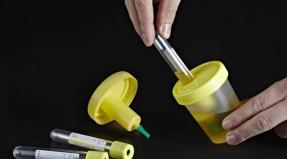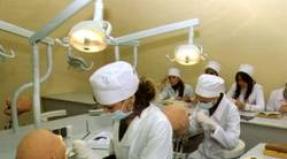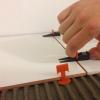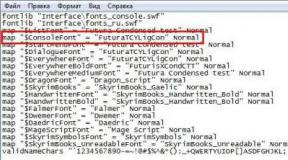Complete interpretation of syphilis tests. RPR syphilis test How to prepare for a PRP syphilis test
False negative (false negative) results occur when high concentration antibodies that inhibit agglutination (prozone effect), which can be avoided with serial dilutions
serum.
On average, the false-negative rate of non-treponemal tests (VDRL) in secondary syphilis is about 1%. False negative results of non-treponemal tests must be distinguished from negative non-treponemal tests at different periods of the course of syphilis, when the body has not yet developed antibodies or when the number of antibodies decreases significantly due to a decrease in the amount of lipid antigen.
Frequency of negative non-ponemal tests at different periods of syphilis
Causes of a false positive test for syphilis
The decision maker may be due to technical errors and errors in the performance of research, as well as the quality of the reagents. Despite the numerous advantages of diagnostic kits for RPHA, ELISA and RIF and their modifications used to diagnose syphilis, in some cases, unreliable test results are noted.
This may be due to both the insufficient level of qualifications and professional responsibility of the personnel (so-called non-biological or technical errors), and the peculiarities of the tested samples (biological errors).

False positive non-treponemal tests
The main reasons for biological false-positive reactions are associated with the fact that antibodies to cardiolipin (the main component of mitochondrial lipids, especially cardiac muscle - hence the name), which appears in the body during tissue destruction during
some diseases and conditions.
Thus, non-treponemal tests determine the so-called reaginic antibodies, which the body has developed not against the causative agent of syphilis - treponema pale, but against the consequences of syphilitic infection.
However, reagin antibodies are produced not only to the lipids of destroyed tissues, but also to the lipids of the membrane of pale treponema, but more than 200 antigens, similar in composition to the lipid antigen of pale treponema, have been identified.
False positive treponemal
tests
The causes of false positive treponemal tests are unknown. The percentage of their occurrence is very low.
It is noted that false positive treponemal tests are most common in systemic lupus erythematosus and in Lyme disease (borreliosis). Since anti-treponemal antibodies are produced by cells of immunological memory for quite a long time, there are hypotheses about short-term contact of the body with treponema pallidum, which did not lead to infection with syphilis, but caused the production of anti-treponemal
antibodies.
Undoubtedly, the appearance of positive non-treponemal and treponemal tests in non-venereal trepanematosis - this is not considered a false positive biological reaction, but it does not confirm the presence of syphilis.
The error in performing treponemal tests is a maximum of 5%. Non-treponemal ones are much more likely to show a false result. The most common reasons for this phenomenon are:
- malignant neoplasms;
- infection with Koch's bacillus (tuberculosis) in any form;
- pathology of an enteroviral nature;
- Infectious mononucleosis;
- hepatitis of all types;
- pneumonia;
- Lyme disease
- alcoholism;
- addiction;
- dermatitis;
- vaccination that was performed less than 21 days before the analysis;
- diabetes of all types;
- age over 70;
- pregnancy.
This is the name of the presence of a positive reaction to syphilis according to the data of serological examination in the actual absence of the disease. Find out the reasons for the body's reaction to the test in this article. It is very important to distinguish false positive syphilis from seroresistance and seropositivity.
Is a positive reaction in a blood test possible in the absence of syphilis?
Yes, you can get a false positive reaction if you have:
diabetes;
pregnancy;
oncological diseases;
tuberculosis;
pneumonia;
alcoholism or drug addiction;
you have recently been vaccinated.
If you get a positive blood test for syphilis, you need to immediately undergo a detailed examination by a venereologist in order to start treatment as soon as possible.
Study types
False positive reactions of treponemal and non-treponemal tests can be observed in infectious diseases, the causative agents of which have antigenic similarity to treponema pallidum.
It is relapsing fever, leptospirosis, tick-borne borreliosis, tropical treponematoses (yaws, bejel, pint), and inflammatory processes caused by saprophytic treponemes of the oral cavity and genitals.

The causative agents of endemic treponematoses (yaws, pinta, bejel) are treponemes that have genus-specific antigens similar to those of T. pallidum. In this regard, the antibodies formed against them are capable of entering into cross-interactions with the antigen of the causative agent of syphilis.
Russia is not a territory endemic for this group of diseases. These infections are found mainly in Africa, Latin America and South Asia, and cases are rare in hospital practice.
A patient with positive serological reactions to syphilis, who arrived from a country with endemic treponematosis, should be examined for syphilis and anti-syphilitic treatment should be prescribed, if it has not been previously performed.
Biological false positive Wasserman test
There are 2 main groups of research methods for syphilis: direct and indirect.
- The direct method is a study in which the infection itself is looked for in the biomaterial - individual representatives of the pathogen as a whole, or their pieces - DNA.
- Indirect methods (serological tests) are tests in which they try to detect antibodies to the causative agent of syphilis in the blood. The logic is as follows: if an immune response characteristic of some infection is found, then there is the infection itself, which caused this immune response.
Direct methods are the most reliable: if the bacterium is "caught red-handed", then the presence of the disease is considered proven. But pale treponema is difficult to catch, and negative test results do not exclude the presence of infection.
It makes sense to carry out these studies only in the presence of rashes and only with an early form of syphilis - up to two years of illness. T.
That is, it is impossible to determine latent syphilis or its late forms with these methods, therefore, in clinical practice they are rarely used and only to confirm other analyzes.
Direct methods include: Dark-field microscopy, Infection of laboratory animals, PCR.
- Dark-field microscopy (TPM) - examination of pale treponema under a microscope. The material is taken from hard chancre or eruptions. The method is cheap and quick, and detects syphilis at the very beginning of the primary period, when blood tests for syphilis are still negative. But bacteria in the rash, which are in small quantities, can easily not get into the scraping. Plus pale treponema can be easily confused with other inhabitants oral cavity, anal canal, etc.
- Infection of laboratory animals is a very expensive and painstaking method, it is used only in research practice.
- PCR is a relatively new method, it looks for DNA infection. Any tissue or fluid that may contain pale treponemas is suitable for research: blood, urine, prostate secretions, ejaculate, scraping from skin rashes, from the genitourinary tract, oropharynx or conjunctiva. The analysis is very sensitive and specific. But complicated and expensive. It is prescribed in case of questionable results of other tests.
Indirect methods, they are also serological reactions, are the basis of laboratory testing for syphilis. It is these methods that are used for mass screening of the population, for confirming the diagnosis and monitoring treatment. Indirect research methods are divided into non-treponemal and treponemal tests.
Non-treponemal tests are noticeably cheaper. For their implementation, not the protein antigen itself, which is specific for syphilitic treponema, is used, but its replacement, the cardiolipin antigen.
These tests are highly sensitive but poorly specific. This means that such tests will indicate everyone who has syphilis and even more: healthy people there may also be false positive results.
They are used for mass screening of the population, but in the case of a positive result, they must be confirmed by more specific tests - treponemal.
Non-treponemal tests are also very useful in assessing the effectiveness of treatment: with effective treatment, the volume of antibodies in the blood decreases, and, accordingly, their titer decreases (we will talk more about these titers a little further).
The most reliable result of these non-treponemal tests will be during early syphilis, especially during the secondary period.
Non-treponemal tests include:
- The Wasserman reaction (RW, aka RV, or RSK) is already outdated and not used, but because of the strong association with the disease, any tests for screening the population for syphilis are often called so. If you see a record "RV analysis" in the direction from the doctor - do not be embarrassed, the laboratory will probably understand everything correctly and will do RPR.
- The microprecipitation reaction (MR, aka RMP) is a simple and cheap test to determine syphilis. It was previously used as the main non-treponemal test, but has now given way to the more convenient and objective RPR test.
- Rapid plasmareagin test (RPR-test) is a quick, simple and convenient test for mass screening of the population and control of treatment. It is the main non-treponemal test used in Russia and abroad.
- TRUST is a more modern modification of the RPR test. In another way, it is referred to as the RPR test with toludine red. In Russia, it is used only in a small number of laboratories.
- VDRL - This analysis is similar in reliability to the RMP and is also inferior to the RPR. It has not found wide application in Russia.
- The USR test (or its modification - the RST test) is a more advanced VDRL test, but it is also used extremely rarely in Russia.
Treponemal tests are performed with treponemal antigens. They are more specific, and therefore more carefully weed out the healthy from the sick.
But their sensitivity is lower, and such tests can miss a sick person, especially on early stage disease. Another feature is that treponemal tests appear later than non-treponemal tests, only three to four weeks after the appearance of a hard chancre.
Therefore, they cannot be used as screening devices. The main purpose of treponemal tests is to confirm or deny the results of non-treponemal tests.
Treponemal test results will also remain positive for several years after successful treatment... Because of this, they are not used to monitor the effectiveness of treatment, and they are also not relying on the results of these tests unless they are confirmed by non-treponemal tests.
Treponemal tests include:
- RPGA (or its more modern modification - TPRA, TPNA) - reaction passive hemagglutination... The main treponemal reaction now used abroad and in Russia. A simple and convenient test for detecting syphilis antibodies in the body.
- ELISA (anti-Tr. Pallidum IgG / IgM) - enzyme-linked immunosorbent assay, aka ELISA with an English abbreviation. This test can be performed with both cardiolipin antigen and treponemal antigen. It can be used both for screening and as confirmation. In terms of reliability, it is not inferior to RPHA and is also the recommended treponemal test to confirm the diagnosis of syphilis.
- Immunoblotting is a more expensive advanced ELISA test. Used only in doubtful cases.
- RIF is the reaction of immunofluorescence. Technically difficult and expensive analysis. It is secondary, it is used to confirm the diagnosis in doubtful cases.
- RIBT (RIT) - a reaction of immobilization (immobilization) of pale treponema. This reaction is complex, time consuming to execute and difficult to interpret the result. In some places it is still used, but gradually fades into the background, giving way to RPGA and IFA.
Decoding of serological tests for syphilis:
V initial stage you can use a bacterioscopic method based on determining the pathogen - treponema pale - under a microscope. In the future, serological tests based on the determination of microbial antigens and antibodies produced by the body in biological material are widely used.
Bacteriological research is not carried out, since the causative agent of syphilis grows very poorly on nutrient media in artificial conditions.
All methods for detecting treponema, that is, types of tests for syphilis, are divided into two large groups:
1. Direct, which directly detect the microbe itself:
- dark-field microscopy (detection of treponema on a dark background);
- RIT test - infection of rabbits with the test material;
- polymerase chain reaction (PCR), which detects sections of the genetic material of a microorganism.
2. Indirect (serological), based on the detection of antibodies to the microbe, which are produced by the body in response to infection.
Serological tests are divided into two groups
Non-treponemal:
- the reaction of binding of complement with cardiolipin antigen (RSKk);
- microprecipitation reaction (RMP);
- Rapid Plasma Reagin Test (RPR);
- test with toluidine red.
Treponemal:
- the reaction of binding complement with treponemal antigen (PCT);
- treponema immobilization reaction (RIT or RIBT);
- immunofluorescence reaction (RIF);
- passive hemagglutination reaction (RPHA);
- enzyme immunoassay (ELISA);
- immunoblotting.
The methods of these analyzes are quite complex, so we will focus mainly on when they are carried out and how accurate the information is.
Let's say right away that the basis for diagnosing syphilis is serological methods. What is the name of the analysis for syphilis: in each case, the examination may include different methods. Below we will talk about them in more detail.
There are several laboratory diagnostic methods for detecting syphilitic infection:
- Bacteriological research.
- Immunofluorescence reaction.
- Immobilization of pale treponemas (RIBT).
- Immunoassay for syphilis.
- Passive hemagglutination reaction.
- Microprecipitation reaction with cardiolipin antigen.
- PCR to detect the presence of the genetic apparatus of the pathogen.
This serological test is convenient for its simplicity and speed. It is used when undergoing professional examinations, as well as when donating blood at blood transfusion stations.
The object of the study is blood from the cubital vein. Blood sampling is performed from the patient on an empty stomach. Purpose - to establish antibodies to cardiolipin-phospholipid antigen of treponema pallidum. This antigen is an integral part of the cell membrane of the microorganism that causes syphilis.
Antibodies that react to a given antigen are determined. The Wasserman reaction is considered positive if a precipitate forms when the patient's blood interacts with cardiolipin.
This precipitate is an immune complex between antibodies and antigens. If there are no antibodies to this antigen in the patient's blood, then the clot does not form and the reaction is considered negative.
There are several types of blood tests for syphilis that are performed equally frequently. First of all, it is necessary to note a serological blood test, which is done three times during pregnancy, and is also the most used in mass medical examinations.
The blood taken for analysis is freed from the blood balls and examined for the presence of antibodies produced by the body to fight the infection.
Separately, it is necessary to say about RW (Wasserman reaction), in which blood is taken from the cubital vein, and the result becomes known only after 6-7 weeks.
Moreover, if the disease is at the seronegative stage, one cannot rely on a negative result obtained with RV. It must be borne in mind that the analysis may well show a false positive result in case of pregnancy and after syphilis has already been cured.
To determine antibodies to treponema pallidum in the blood, the following tests are used:
- RIF or FTA (immunofluorescence reaction) - the reaction of absorption of fluorescent antibodies is determined.
- RPHA or TPHA (passive hemagglutination reaction) is a syphilis test that detects IgM and IgG antibodies.
- ELISA or ELISA - the name stands for enzyme immunoassay, determines the quantitative content of IgG and IgM antibodies.
Syphilis can detect treponemal and non-treponemal tests. The first test for syphilis detects antibodies in the blood against antigens to Treponema pallidum. The second detects antibodies against the tissues that the bacteria destroyed.
ELISA is an effective test method that is done not only to determine the presence of an infection, but also to determine the stage of the disease. In addition, ELISA is able to answer the question of whether a given person has ever had syphilis. ELISA sensitivity can reach 90%.
ELISA analysis allows you to determine antibodies to Treponema pale: immunoglobulins - G, M, A. Their concentration allows you to trace the process of the disease in its dynamics.
Immediately after infection, the immunity to fight the bacterium produces IgA antibodies, two weeks later - IgM. After a month, IgG appears. When they start to show clinical symptoms ailment, blood for syphilis shows a sufficient amount of antibodies of all three types.
Studies show that syphilis-specific IgM antibodies decrease dramatically after effective treatment. The peculiarity of IgG antibodies is that the test for syphilis detects them even long after the cure and throughout the patient's life.
Therefore, a positive ELISA result does not always mean the presence of the causative agent of syphilis. A positive test can determine both the stage of development of the disease, and what was recently carried out effective treatment, and therefore antibodies still circulate in the blood.
A negative ELISA result can mean both the absence of the disease and its early stage.
There are the following research options:
- nonspecific tests (MR, RW): determine the presence in the blood of nonspecific the causative agent of syphilis reagin antibodies;
- specific tests (RIF, ELISA, RIBT, RPGA): detect the presence of specific antibodies against treponema pallidum;
- PCR test, which determines the DNA of the pathogen in the test material.
With mass screening, only a non-specific test is done, since this is the fastest and easiest diagnostic method. And only if, when deciphering the analysis for syphilis, it turns out to be positive or weakly positive, a detailed specific test is done.
Usually, three tests are required to make a definitive diagnosis: one nonspecific and two specific.
During pregnancy, tests are taken three times for prophylaxis, while non-specific tests are always used.
Non-treponemal tests
Although nonspecific, or nontreponemal, as they are also called, tests are available to everyone, they cannot be considered accurate enough. This is just an express technique, in which a negative result does not guarantee the absence of infection, and a positive one also often turns out to be false.
The MR test is used throughout Europe. The Wassermann reaction (RW), which is named after the German immunologist, is more common in the post-Soviet space.
Algorithm for diagnosing syphilitic infection at different stages
In the primary seronegative period (up to 2 months after infection), treponema is searched for in a dark field or using fluorescent antibodies.

For primary seropositive, secondary and latent syphilis, RMP and ELISA are used, and RPHA is used as a confirmatory test.
In patients with relapses of secondary syphilis, the elements of the rash are examined, trying to isolate treponemas from them for microscopic examination.
In the tertiary period, bladder cancer in one third of patients is negative. ELISA and RPGA are positive, but they may indicate not tertiary syphilis, but a previous illness. A weakly positive test is more likely to indicate recovery than tertiary syphilis.
When diagnosing congenital syphilis, the presence of the disease in the mother, the difference in bladder cancer in the mother and the child, positive ELISA and RPHA in the newborn, and immunoblotting are taken into account.
Pregnant women are necessarily examined for syphilis, especially those who have already had a dead fetus, undeveloped pregnancy, and early miscarriages. He performs RMP, IFA, RPGA. Examined for the presence of disease and before termination of pregnancy.
Confirming or excluding syphilis: history, symptoms, tests
Only a dermatovenerologist can confirm or exclude the diagnosis. A urologist or gynecologist can only suspect an illness based on external signs. And then they should refer the patient to a dermatovenerologist for further examination, treatment and observation.
The diagnosis of syphilis is based on a combination of the following symptoms:
- On the presence or absence of external manifestations and symptoms.
- Based on the results of at least two laboratory tests: non-treponemal (RMP, or RW, or RPR) and treponemal (RPHA or ELISA) tests.
- On data about whether syphilis was previously, and whether it has already been treated.
If symptoms are present
 Basic Syphilis Tests - RPR and RPGA
Basic Syphilis Tests - RPR and RPGA - The most obvious and reasonable diagnosis is considered when there are clinical symptoms and confirmatory results of two tests: RPR (or RW, RMP) and RPHA (or ELISA).
- If, in the presence of symptoms, the test results diverge, and the RPR is negative, and the RPHA (or ELISA) is positive, an additional treponemal test is performed - ELISA (or RPGA, if ELISA was first performed). In the case of a positive additional analysis, the diagnosis is considered proven and treatment is carried out, in the case of a negative one, the blood is sent to an expert laboratory.
Negative RPR with positive ELISA / RPHA usually occurs in the late period. Then for the presence of infection, be sure to investigate cerebrospinal fluid(RIF-c, RIT). - The opposite situation, when RPR is positive, and RPHA is negative (or doubtful) are extremely rare. This is possible in the first 3-4 weeks after the appearance of a hard chancre, as well as in the secondary period during the immune "prozone" (excessive amount of antibodies). In this case, the analysis is recommended to be repeated.
If there are no external signs
Then the diagnosis becomes more difficult. Here, doctors rely only on tests and information about ongoing or not previously carried out treatment.
Options in this case:
- If the non-treponemal (one of the RMP / RW / RPR) and treponemal tests (RPHA / ELISA) are positive, an additional alternative treponemal test is performed (ELISA, if the first test was RPHA, and vice versa - RPHA, if there was an ELISA). If the test becomes negative, then the patient's blood is sent to an expert laboratory and additional tests are performed. If the second treponemal test becomes positive, the diagnosis is made: "latent syphilis". This condition can be observed for some time after the treatment. If the patient has undergone treatment before, then in order to confirm the diagnosis, an additional study for I gM is performed. If the results are positive, the diagnosis is confirmed, but the study is still recommended to be repeated after 2 weeks. With negative results, syphilis is refuted.
- If the non-treponemal test (RMP / RW / RPR) is negative, and the treponemal test (RPHA / ELISA) is positive, then the condition can be assessed as “late syphilis” or “absence of syphilis” if the patient has received full treatment before. To distinguish between these two conditions, an additional test for I gM is performed (ELISA I gM, RIF -abs-I gM, Immunoblotting-I gM). If I gM is present in the blood, "late syphilis" is put on and treated. If not, the patient is considered healthy.
- If RPR (or RW / RMP) is positive, RPHA is positive, and ELISA is negative (or vice versa: RPGA "-" and ELISA "+"), then the test results are in doubt and it is recommended to send the blood to an expert laboratory or conduct alternative tests (RIF, Immunoblotting).
- If the non-treponemal test (PMP / RW / RPR) is positive and the treponemal test (RPHA / ELISA) is negative, then an additional treponemal test (ELISA / RPGA) is performed. If he gives a positive result, then the blood is sent to an expert laboratory. If negative, then the diagnosis is refuted, and the result of the non-treponemal test is considered false positive.
Diagnosis of different periods of syphilis
There are two main types of tests for syphilis: treponemal and non-treponemal.

In the case of primary syphilis, for microscopic examination, the discharge of erosive and ulcerative elements (primary syphiloma), as well as puncture of regional lymph nodes, are taken.
During the diagnosis of the secondary period of syphilis, a biological material taken from the sites of mucosal or skin lesions is examined under a microscope.
Congenital syphilis is diagnosed by examining the amniotic fluid (amniotic fluid). Under the microscope, pale treponema looks like a thin spiral with 8 to 12 curls.
In the middle part of the spiral, a break is observed, which is characteristic only of the causative agent of syphilis and distinguishes it from other treponemas.
How to get tested for syphilis?
The Wasserman reaction is a laboratory study designed to determine the presence of antibodies in a person's blood to the causative agent of syphilis (Treponema pallidum, pale treponema). The topic of this article is a blood test for syphilis. Interpretation of the results will help to correctly diagnose the disease.
The Wasserman reaction as such is considered an outdated method and has not been used in clinical practice since the end of the 20th century. Nowadays, the microprecipitation reaction is widely used for diagnostics. However, traditionally, doctors call all laboratory methods for diagnosing syphilis the Wasserman reaction or RW.
Your doctor will ask you to have a blood test for syphilis if:
you practice casual sex;
you are preparing for surgery;
or are planning a pregnancy;
if you have sores on your genitals or discharge from the genital tract;
if you have bone pain.
Even if none of these points apply to you, you may be referred for a blood test for syphilis for prophylactic purposes.
Your blood will be taken for analysis in the morning. For 8, or even better 12 hours before the analysis, you should not eat. You should also refrain from tea, coffee, juices, and even more from alcohol. You can drink plain water.
The result of a blood test for syphilis will be ready in a day.
Interpreting Syphilis Test Results
If you get a negative result, you can most likely breathe freely. You have not been diagnosed with an infection.
True, in this case, it is better to undergo a more detailed examination, since with early primary and late tertiary syphilis, a blood test for syphilis can also give a negative result.
If your test is positive, you will have to tune in to long-term treatment. You have primary, secondary, or seropositive tertiary syphilis. A positive result is also possible within the first year after the cure.
Serological blood tests in the diagnosis of syphilis
Serological laboratory tests used today are divided into two types:
non-treponemal (for selection);
treponemal (confirming).
Many patients feel tremendous doubt after testing. Correct requires special medical experience.
A special test with toluidine red is often used to check the treatment of a disease. Such a study is able to reveal the exact amount of antibodies at the time of treatment.
If the numbers change downward, then the effectiveness of therapy is observed. If, on the contrary, the doctor selects an alternative solution for this problem.
 Research Algorithm
Research Algorithm Nonspecific tests are prescribed during the physical examination for all patients. The finished results can be deciphered by yourself:
- if there is "-" here, then this indicates the absence of pathogenic microorganisms in the blood;
- "+" Or "+1", the result of the analysis for syphilis indicates a mild reaction;
- "3+" or "+4" denotes a positive result for syphilis.
How is the analysis taken
Test results and clinical manifestations directly depend on the body's immune response.
Early syphilis
Different diagnostic methods show different sensitivity and specificity depending on the form and stage of syphilis. The likelihood of an erroneous diagnosis increases, especially in cases of a latent, latent, combined course of the disease.

False negative serological reactions to syphilis can be observed in secondary syphilis due to the phenomenon of prozone when testing undiluted serum, as well as when examining people with an immunodeficiency state, for example, HIV-infected patients.
Biologically induced false negative serological specific reactions (SRS) results may be due to competition between specific IgM and IgG for binding to antigen on the surface of erythrocytes, as well as to the “prozone phenomenon”.
In the latter case, agglutination does not occur due to the overproduction of antibodies to treponema pallidum, since each antigen receptor on erythrocytes is bound to one agglutinin molecule due to an excess of antibodies, which prevents the formation of a "lattice".
Replacing RPGA with TPPA, i.e. erythrocytes to synthetic particles, apparently, will eliminate or minimize the receipt of false negative results.
How to get tested for syphilis for free?
To get a referral to the laboratory, you need to visit your GP. If you want to get tested faster, you can do it in a private laboratory without a referral (for example, the Invitro laboratory does the analysis for syphilis quickly and anonymously).
How to get tested for syphilis? Blood is taken in the morning, on an empty stomach. You can only drink clean water.
Preparation: two days before the test, fatty foods and especially alcohol should be excluded from the diet.
How is the analysis taken? in the usual way from a finger or an ulnar vein.
How much is the test for syphilis done? The test result is usually ready the next day. The transcript can be taken from a doctor or laboratory.
How long is the analysis valid? For up to three months.
In some cases, for the diagnosis of neurosyphilis, an analysis of the cerebrospinal fluid is taken.
This examination is prescribed to all patients with latent syphilis, if they have signs of a pathology of the nervous system, as well as latent and late neurosyphilis.
In addition, the analysis is performed in all patients after recovery, while maintaining their positive serological reactions. We already wrote in our article that this phenomenon happens quite often.
The analysis of cerebrospinal fluid in syphilis is prescribed and carried out only by a doctor.
Cerebrospinal fluid is obtained by puncturing between two vertebrae lumbar... It is collected by 4 ml in two test tubes.
Then the puncture site is treated with iodine and covered with a sterile bandage. After the puncture, the patient should lie on his stomach with the raised foot end of the bed for at least 3-4 hours, then he can lie on his side.
Bed rest after puncture is shown for two days.
The liquor from the first test tube is examined using conventional reactions to the content of protein, cells, determination of signs of meningitis (inflammation of the meninges).
The cerebrospinal fluid from the second test tube is examined for antibodies to treponema using the Wasserman reaction, RMP, RIF and RIBT, which we talked about above.
According to the severity of violations, four types of changes in the cerebrospinal fluid are distinguished. By analyzing them, the doctor can conclude that there is different forms lesions of the nervous system (vascular neurosyphilis, syphilitic meningitis, meningo-vascular syphilis, tabes dorsal, late mesenchymal neurosyphilis), as well as the recovery of a patient with positive serological tests.
With a negative analysis for syphilis, the likelihood of primary or late tertiary syphilis still cannot be ruled out, and a positive result can be detected in a healthy person who was completely cured a year ago.
The fact is that antibodies to syphilis cannot be detected if the infection occurred less than 5 weeks ago. In addition, at the tertiary stage, the amount of the same antibodies is markedly reduced, which can also be misleading and give a negative result.
It is possible to finally establish the absence of syphilis in a person only after conducting other tests. As well as a positive result, it is necessary to confirm using several other specific and more sensitive tests.
A blood test for syphilis is usually done in the morning. The patient for at least 8 hours before the analysis should refrain from eating, as well as not consume alcohol, juices, tea and coffee. In addition, it is advisable not to smoke half an hour before the test.
Thyroid-stimulating hormone THT What is Thyroid Stimulating Hormone (THT)? Thyroid stimulating hormone - normal, increased and decreased. Indications for analysis. What function does it perform.
The norm of cholesterol in the blood in women The norm of cholesterol in the blood in women of different ages. Low and high level cholesterol in a woman.
Segmented neutrophils are lowered Segmented neutrophils are lowered, which affects the result. Indications and preparation for analysis. The norm of segmetonuclear neutrophils.
Since the bladder cancer and RPR tests are very sensitive to the slightest changes in the blood and often give false results, it is very important to properly prepare for these tests.
- The day before donating blood, you must not drink alcohol and take psychotropic substances
- In 4 hours - no need to eat
It is also not recommended to take tests if during this period a person suffers from some other infection, because the likelihood of false positive results will be even higher. This is due to the fact that other antibodies in the blood (for example, to colds or injury).
Deciphering the analysis for syphilis can show a false result. The human factor is considered an important aspect. Improper preparation for blood sampling also negatively affects diagnostic measures... There are several reasons that show a false positive reaction:
- pregnancy;
- diabetes;
- diseases of the heart system;
- autoimmune lesions;
- the presence of medicinal and psychotropic substances in the blood.
Pregnant women for syphilis are examined especially carefully, since this infection even after complete cure can interfere with normal bearing for many more years.
Moreover, in children born to mothers who are ill or have had syphilis, the disease often develops congenital. Therefore, you need to take express tests during pregnancy more than once.
Usually, this analysis is performed three times during the entire pregnancy.
Anonymity of treatment
- Incredible ... You can cure syphilis, gonorrhea, mycoplasmosis, trichomoniasis and other sexually transmitted diseases forever!
- This time.
- No antibiotics!
- These are two.
- During the week!
- These are three.

An effective remedy exists. Follow the link and find out what the venereologist Sergey Bubnovsky recommends!
How to get rid of syphilis and what kind of treatment do you need to undergo? It should be noted right away that only an experienced doctor should prescribe treatment. Syphilis is treated with antibiotics for a long time.
It takes at least 2 years for the blood to clear of antibodies. The blood is purified slowly and gradually.
That is, after the treatment received, antibodies are produced less and less and eventually cease to be determined in the blood. To control this process, patients have to squeeze tests for 3 years.
A blood test for syphilis is mandatory for people of many professions (doctors, military men, cooks, etc.) to obtain permission to work.
In this case, a serology or other type of analysis will be assigned constantly, at each medical examination. During pregnancy, a study for syphilis is also mandatory, tests are prescribed by a doctor.
Some types of tests, such as RIF, are often false positives. What are the most accurate tests for syphilis today, the doctor will tell you.
People, especially men, rarely want to see a doctor regularly. As for syphilis, the reason for this may be both the symptoms of a sluggish disease that do not manifest themselves, and shame, unwillingness to let others know about the disease.
How to prepare for the procedure
For a blood test for syphilis, in different cases, capillary or venous blood can be taken. Home rapid tests give the answer one drop of blood from a finger.
In this case, no special training is required. General recommendation: Refrain from smoking immediately before sampling, and from alcohol for 24 hours.

Similar requirements are put forward for the fence venous blood... For patients with immune problems, it is additionally advised not to engage in heavy physical labor on the eve of tests. The day before sampling, it is best to eat light food and sleep well.
Venous blood donation is performed in the morning on an empty stomach.
Post Views: 6 861
Unlike Trichomonas or gonococcus, treponema pallidum cannot be detected in smears. If a person does not have obvious signs of a disease, then the best biological material for research in order to diagnose syphilis is blood. A blood test for syphilis is quite reliable even when the patient has syphilis.
Do not be surprised if you are asked to undergo a blood test for syphilis during a medical examination before applying for a job, surgery, or during pregnancy. This is a common procedure for screening the population. Thus, carriers of infection and patients are identified in the early stages.
Anyone who has practiced unprotected sex or suspects a partner of being a carrier may have a desire to conduct express diagnostics. Today it is possible to independently test at home.
A blood test for syphilis is of particular importance in the process of treating an infection: the results are used to judge the effectiveness of the chosen method of therapy and draw conclusions about the patient's recovery.
A referral for analysis can be obtained not only from a venereologist-dermatologist, but also from a therapist, gynecologist or urologist. Self-initiated analysis is done by purchasing a rapid test kit from a pharmacy.
How to prepare for the procedure
For a blood test for syphilis, in different cases, capillary or venous blood can be taken. Home rapid tests give the answer one drop of blood from a finger. In this case, no special training is required. General recommendation: Refrain from smoking immediately prior to sampling and from alcohol for 24 hours.
Similar requirements are put forward for the collection of venous blood. For patients with immune problems, it is additionally advised not to engage in heavy physical labor on the eve of tests. The day before sampling, it is best to eat light food and sleep well.
Venous blood donation is performed in the morning on an empty stomach.

Methods for finding treponema or its traces
The basis laboratory methods the diagnosis of syphilis by blood is based on the body's ability to give an immune response to the appearance of the pathogen. Since plasma or blood serum is examined, the entire group of reactions was called serological.
Serological diagnosis of syphilis includes non-treponemal and treponemal antibody detection tests. The former are more often used for screening and assessing the effectiveness of treatment, and the latter for diagnostics.
For the first time, serodiagnosis of syphilis was carried out by August Wasserman in 1906. Until now, it has not lost its relevance and is called in honor of the developer - the Wasserman reaction (PB, RW) or the complement fixation reaction (RSK).
Over 100 years, laboratory practice has evolved significantly, and now IgM and IgG antibodies are detected in the following ways (table 1).
Non-treponemal reactions
The term "non-treponemal" combines reactions that detect antibodies not to the pathogen, but to the lipids of the destroyed treponemal membranes or host cells. During the precipitation reaction, the reagent (cardiolipin antigen) interacts with antibodies (if any) and the antigen-antibody complex precipitates. White flakes form in the test tube. The laboratory assistant evaluates the result with the naked eye in cases of RPD, MPR, RST and TRUST or under a microscope (VDRL, USR). The reaction is considered:
- positive when large flakes appear (4+, 3+);
- slightly positive when medium-sized flakes appear (2+, 1+);
- negative - no flakes (-).
From the moment of infection to a positive reaction of non-treponemal tests, it can take up to 1.5 months. Chancroid shows syphilis 1-4 weeks earlier than the test.
The titer of the falling antibodies is measured during a quantitative precipitation reaction. For this, plasma or serum is diluted according to the instructions. This analysis characterizes the effectiveness of the treatment. If the titer falls, then the recovery is successful, if the state of affairs does not change, the drugs should be changed.
When it comes to a microreaction, it means that a few drops of the test material are required. These tests are very convenient for screening large populations or for home use. Assay kits are cheap and standardized. For example, "Syphilis-AgKL-RMP" manufactured by CJSC EKOlab, Profitest from New Vision Diagnostics, SD BIOLINE manufactured by Standard Diagnostics.

The disadvantage of precipitation reactions is their low accuracy. Primary syphilis RPR detects in the range from 70 to 90%, secondary - by 100%, and late - 30-50%. False positive results on non-treponemal tests are rare and occur in 3% of cases. Accurate results can be hindered by errors in the collection, storage of blood samples, or inappropriate testing procedures.
Syphilis is not diagnosed by a positive precipitation reaction. To make a decision, specific treponemal tests are required.
Treponemal tests
In the patient's blood, antibodies can be detected directly to the treponema antigens. For this, specific methods of serodiagnostics have been developed. These tests are highly sensitive.
- Wasserman reaction
The most familiar and time-tested is the Wasserman reaction (RV) to syphilis. To carry out it, 5 ml of blood is taken from the cubital vein, serum is obtained from the sample, its own complement is inactivated, and then one part is treated with treponemal antigen, and the other with cardiolipin antigen.
The result is assessed by the rate of hemolysis:
- complete or significant delay in hemolysis - a positive reaction (4+, 3+);
- partial delay - weakly positive (2+);
- insignificant delay - dubious reaction (1+);
- complete hemolysis - negative result (-).
Positive qualitative results are verified quantitatively. The titre of reagins is considered the maximum dilution of blood serum until a complete or significant delay in hemolysis. A quantitative RV test is prescribed to assess the effectiveness of treatment.
It makes sense to carry out the Wasserman reaction 2-3 weeks after the appearance of the chancre. She will show secondary syphilis in 100% of cases, tertiary - in 75%.
- Passive hemagglutination reaction (RPHA)
The test preparation is prepared from animal erythrocytes by sensitization with Treponema pallidum antigen. The cells are added to the patient's serum. The test time is 1 hour. In the presence of antibodies, an agglutination reaction occurs, and the laboratory assistant sees specific patterns in the microwells.
Test decoding:
- a ring of agglutinated cells - a positive result (4+, 3+, 2+);
- loose ring - dubious result (+/-, 1+);
- center point is negative (-).
The passive hemagglutination reaction gives positive results long after the cure. A false positive answer can be obtained in cases of infection with leprosy or mononucleosis. Quantitative RPHA is carried out by dilution of samples.
- Immunoassay (ELISA)
It is used for early diagnosis of syphilis. Determines the presence of IgM, IgA, IgG antibodies to treponema using human immunoglobulins labeled with an enzyme and a special reagent. The answer is determined by the change in the color of the samples: the more antibodies, the richer the color of the mixture.
The method is very sensitive and specific. It does not give false positive results when patients have other infections. High sensitivity to antibodies limits the possibility of using ELISA to control the degree of cure.

- Immunofluorescence tests (RIF)
Analyzes of this group make it possible to quickly identify infection with treponema before the appearance of a chancre. Gives positive results by the end of the first week after infection. The sensitivity is close to 100%. Active ingredient the test are fluorescein antibodies to human globulins. Combining with serum antibodies, they create luminous complexes. The test result is determined by the intensity of the glow:
- yellow-green bright glow - 4+;
- green - 3+;
- pale green - 2+;
- barely noticeable glow - 1+;
- background coloring or shadows are negative.
- Treponema pallidum immobilization reaction (RIT)
The test is used to identify latent forms of syphilis. It is time consuming and technically challenging. The technique is based on the phenomenon of immobilization of living treponemas by the “antigen + antibody” complex. The bacteria for the test are cultured in rabbits. All testware must be sterile. Blood is taken from the patient, provided that he took antibiotics no later than a month before the day of analysis. Treponemes are added to the serum. In the eyepiece of a microscope, a laboratory assistant looks for immobile bacteria.
Decoding the result:
- if the immobilization of treponema is more than 50% - the result is 4+;
- 31-50% - weakly positive 3+;
- 21-30% - dubious 2+;
- up to 20% - negative.
- Immunoblot (Western-blot)
Most modern method diagnosis of syphilis, excluding false positive responses from other specific tests. In clinical practice, it is used as a confirmation. The patient's blood serum is applied to a nitrocellulose membrane coated with electrophoretically separated Treponema pallidum antigens. If IgG and IgM antibodies are present, stripes appear on the test.

The interpretation of the results of the test system is carried out according to the position of the bands and their intensity.
The final diagnosis is based on non-treponemal and treponemal tests.
Sources:
- Akovbyan V.A., Prokhorenkov V.I., Novikov A.I., Guzei T.N. // Syphilis: Illust. hand-in (Ed. V. I. Prokhorenkov). - M .: Medkniga, 2002 .-- S. 194-201.
- Dmitriev G.A., Frigo N.V. // Syphilis. Differential clinical and laboratory diagnosis. - M .: Med. book, 2004 .-- S. 26-45.
- Loseva O.K., Lovenetsky A.N. Epidemiology, clinic, diagnosis and treatment of syphilis: A guide for doctors. - M., 2000.
- A.I. Novikov et al. Western blot as a confirmatory test in laboratory diagnosis of syphilis. - "Wedge. lab. Diagnostics ", 2011, No. 8. - P. 4-45.
- Pankratov V.G., Pankratov O.V., Navrotsky A.L. et al. // Recipe (appendix: International scientific and practical conf. " Modern approaches to the diagnosis, treatment and prevention of sexually transmitted infections ”, Grodno, 2005). - S. 165-169.
- Pankratov V.G., Pankratov O.V., Krukovich A.A. and others // Health. - 2006. - No. 6. - S. 35-39.
- Rodionov A.N. // Syphilis: a hand-in for doctors. - SPb .: Peter, 1997 .-- S. 226-245.
- Hurado R.L. // STDs. - 1997. - No. 3. - S. 3-10.
- Schmidt B.L. // First Russian Congress of Dermatovenereologists: Abstracts. scientific. works. - SPb., 2003. - T. II. - S. 40-
- Romanowski B., Sutherland R., Flick G.H. et al. // Ann. Intern. Med. –1991. - V. 114. - P. 1005-1009. What is serological diagnosis of syphilis
The analysis for syphilis is done using a variety of methods for detecting the pathogen. With the development of pathology, a large number of specific signs appear, therefore, in order to establish an accurate diagnosis, a sick person is examined in a comprehensive manner. General analysis blood is not very informative, it is not used in diagnosing this venereal infection.
Types of research and biomaterials for analysis
Various techniques and biomaterials are used to identify the disease. In the early stages, syphilis is determined using a bacterioscopic test. The samples are examined under a microscope. The device allows you to detect strains of the pathogen. Serologic blood tests are later performed. Thanks to them, antigens and antibodies of syphilis are detected in the samples.
Methods for determining a genital infection are divided into 2 categories:
- Direct, revealing a pathogenic microorganism. These include: dark-field microscopy, RIT-analysis (infection of rabbits with biomaterial for research), PCR method - polymerase chain reaction (with its help, the genetic elements of the pathogen are found).
- Indirect (serological) detects antibodies to the pathogen. They are produced by the immune system as a response to infection.
Serologic techniques are divided into 2 categories: treponemal and non-treponemal.
- Non-treponemal, including: toluidine red test, CSC analysis, RPR-test, blood test by rapid bladder cancer method.
- Treponemal, including: immunoblotting, RSK test, RIT analysis, RIF study, RPGA test, ELISA analysis.
The information content of infection tests is different. More often they do the main types of tests for syphilis, which include serological methods.
Biomaterial for research
To identify pale treponema, a pathogen that looks like a spiral and causes syphilis, samples are taken:
- venous blood;
- cerebrospinal fluid (secretion from the spinal canal);
- the contents of the lymph nodes;
- ulceration tissue.
If it is necessary to conduct tests for the detection of syphilis, blood is donated not only from the cubital vein, but also from the finger. The choice of biomaterial and the method of research is influenced by the severity of the course of the infection and the equipment of the diagnostic center.
Direct research
Convincing evidence of syphilis is the identification of infectious agents under a microscope. In this way, the pathogen is found in 8 out of 10. A negative result in the remaining 2 patients does not mean that they are not infected.
The study is done at the primary and secondary stage (stage) of the disease, which is characterized by the appearance of skin rashes and syphilis (ulceration) on epithelial tissues or mucous membranes. Pathogens that cause venereal disease are found in the discharge from the lesions.
More precisely, a complex test, denoted as RIF - the reaction of immunofluorescence, copes with the definition of treponemes. The sample for research is pretreated with fluorescent antibodies. The compounds capable of glowing stick together with bacteria. Examining samples under a microscope, in case of infection, the laboratory assistant sees sparkling pathogens.

The test is used for early diagnosis of the disease. The longer the disease lasts, the lower the sensitivity of the research methods. In addition, it falls after the treatment of rashes and ulcers with antiseptics and in patients who have undergone treatment. Occasionally research gives false negative and false positive results.
RIT analysis is a highly accurate method for detecting syphilis. When conducting a test, the results have to wait a long time. Until the infected rabbit shows signs of infection. The test is used very rarely, despite the fact that it is super accurate.
By using polymerase chain reaction for syphilis, the genetic elements of pathogens are determined. The only drawback of PCR is its high cost.
Non-treponemal tests
These blood tests help to detect antibodies that appear in response to cardiolipin, a compound related to the general structure of the membranes of pathogens.
Wasserman reaction (PB or RW)
The most famous study for syphilis is the Wasserman reaction. RV is included in the category of complement fixation reactions (CBCs). New RSC methods have significant differences from traditional RW. But they are designated, as before, by the concept of "Wasserman reaction".
The immune system synthesizes antibodies (markers) in response to the invasion of treponemes. They are detected in a blood test for syphilis using the Wasserman reaction method. A positive RW result confirms that the subject is infected.

Hemolysis reaction - RV analysis index. With it, 2 substances interact: hemolytic serum and ram erythrocytes. Serum is made by immunizing a rabbit with ram erythrocytes. The activity of the biological fluid is reduced by heating.
RV indicators depend on whether hemolysis has passed or not. Hemolysis occurs in the sample free of markers. In this case, a reaction to antigens is impossible. Complement is spent interacting with sheep erythrocytes. When there are markers in the sample, the compliment reacts with the antigens. In this case, hemolysis does not occur.
Read also on the topic
What does a chancre look like with syphilis?
The components for RW are measured in equal amounts. The sample containing serum, antigen and compliment is warmed up. Lamb erythrocytes and serum are added to the sample. It is kept at a temperature of 37 degrees until hemolysis occurs in the control sample, which contains saline instead of antigen.
For carrying out RV use ready-made antigens. The titers and the technology of their dilution are indicated on the packages. A positive RW result is indicated by crosses. The finished test results are indicated as follows:
- ++++ - the most positive (hemolysis was delayed);
- +++ - positive (hemolysis is significantly delayed);
- ++ - weakly positive (hemolysis partially delayed);
- + - doubtful (hemolysis was delayed slightly).
With negative PB, hemolysis was completely carried out in all samples. But in some cases, they receive false positive data. This happens when cardiolipin is incorporated into cells. Defense mechanisms do not produce markers to the "native" cardiolipin.
However, exceptional situations occasionally arise. Positive RW is found in uninfected people. This is possible if the patient has suffered a serious illness caused by viruses (pneumonia, malaria, tuberculosis, liver and blood pathologies). Positive RV occurs in pregnant women. This is due to the fact that the immune system is overly weakened.
If there is a suspicion that the test result for syphilis is false positive, the patient is examined additionally. The problem is that this infection cannot be detected by a single clinical laboratory test. Some research gives false indicators, which can be both negative and positive.
A detailed analysis for syphilis helps to obtain reliable data. Thanks to him, a true diagnosis is established: they prove the infection or exclude it. In addition, the extended test allows you to stop the development of infection, exclude unnecessary therapy.
RSK and RMP
When testing for syphilis, the traditional Wasserman reaction is rarely used. Instead, the RSC method is used. The test gives a positive result 2 months after infection. In the secondary form of the disease, it is positive in almost 100% of cases.
Microprecipitation method (PMP) is a study with a mechanism similar to the Wasserman reaction. The technique is simple to implement. It is carried out quickly. For research, blood for syphilis in this case is donated from a finger. The technique gives a positive result 30 days after the appearance of the syphilis. Research errors are not excluded. False positive data are obtained against the background of: exacerbated infections, pneumonia, heart attack, stroke, intoxication.
Leads to erroneous tests:
- tuberculosis;
- Benier-Beck-Shauman disease;
- rheumatoid diseases;
- diabetes;
- cirrhosis;
- brucellosis;
- leptospirosis;
- mononucleosis.
Having found a dubious analysis for syphilis, treponemal studies are done. They help to clarify the diagnosis.
RPR and toluidine red test
The Plasma Reagin Method (RPR) is another analogue of the Wasserman reaction. It is used when necessary:
- screening asymptomatic individuals;
- confirm syphilis;
- examine donated blood.
The toluidine red test, like the RPR, is performed to assess the dynamics of drug therapy. Their indicators fall when the disease recedes, and increase when the pathology recurs.
Treponemal studies
Highly productive tests are performed using treponemal antigens. They are made when:
- a positive result was obtained with the RMP method;
- it is necessary to recognize erroneous data arising from screening tests;
- suspect the development of syphilis;
- you need to diagnose a covertly current infection;
- it is necessary to conduct a retrospective diagnosis.
RIF and RIT tests
In many treated patients, treponemal tests of samples give positive results for a long time. They cannot be used to judge the degree of effectiveness of treatment. RIT and RIF are supersensitive tests. Thanks to them, they get reliable data. These analyzes are laborious, they require a decent amount of time, the availability of advanced equipment. They are able to be carried out by qualified health workers.
Performing the RIF analysis for syphilis, positive data are obtained 2 months after infection. Negative parameters confirm that the subject is healthy. Positive - suggests that the person is infected.
RIT is performed when the microprecipitation reaction is positive. Such a blood test for syphilis helps to deny or confirm the presence of an infection. The test is hypersensitive, it accurately indicates whether the patient is infected or healthy. But the study provides reliable data only 3 months after the penetration of treponemes into the body.
Western blotting method
Ultra-precise tests include immunoblotting. Such a blood test for syphilis is rarely done. It is used when examining newborn children. It is not suitable for express testing. The positive results are received with a delay. The method of microprecipitation gives them much earlier.
Read also on the topic
What do the crosses mean in the analysis for syphilis, what if there are 4 of them?
IFA and RPGA
To informative ultra-precise research methods include ELISA and RPGA tests. With their help, express diagnostics are carried out. Laboratory assistants do a huge number of such analyzes. Thanks to them, it is possible to establish an accurate diagnosis.

RPHA analysis for syphilis is positive 30 days after the penetration of the pathogen into the body. It is used to diagnose the primary infection when ulcers and rashes appear. Thanks to him, it is possible to identify neglected, covertly current, as well as congenital forms of pathology. But it is carried out in conjunction with non-treponemal and treponemal tests. Comprehensive diagnostics guarantees the reliability of the results. Triple testing accurately proves the presence or absence of a sexually transmitted infection.
ELISA analysis is positive 21 days after infection. The test sometimes gives erroneous results. They appear with systemic pathologies impaired metabolic processes... Their effectiveness is questionable in a child born to an infected mother.
Errors obtained with serological methods of research have become the reason for the discovery of progressive diagnostic techniques. Gas chromatography and mass spectrometry do not give false results. The only obstacle to their mass use is their high cost.
Diagnostic algorithm
- When syphilis is in the primary phase (up to 60 days from the moment of infection), the pathogen is looked for against a dark background or fluorescent antibodies are used to detect them.
- If the pathology is in a primary, secondary or latent form, bladder cancer and ELISA are used. An RPHA blood test for syphilis helps to confirm the results.
- With relapses of a secondary infection, the discharge of ulcerations and rashes is analyzed. Pathogens are removed from the samples, studied using microscopy.
- When the disease enters the tertiary phase, 1/3 of patients have negative bladder cancer. At the same time, the results of ELISA and RPHA are positive. However, they do not always indicate the tertiary period, but confirm that the person had an infection earlier. A weakly positive test is evidence of a complete cure, and not the development of a tertiary phase.
- Confirming congenital syphilis, a blood test is taken from the mother and baby. Compare the data of the bladder cancer tests. Consider the fact that the baby's ELISA and RPGA are positive. Confirm the diagnosis using the immunoblotting technique.
Syphilis, like any systemic pathology, affects the entire body. Therefore, examination for him is carried out during pregnancy, before an abortion. Patients are given RMP, ELISA, RPGA.
How to get tested
A venereologist sends patients for analysis. Private laboratories do anonymous testing for syphilis at the request of the client. They do not require a referral from a doctor to take the test.
Research rules:

- In the laboratory, blood is taken in the morning on an empty stomach (eaten after the procedure). Before analysis, only water is allowed.
- 2 days before the examination, it is forbidden to eat fatty foods and drink alcohol.
- Blood is taken from a finger or vein.
- How long does the research take? Usually no more than a day. Deciphering of analyzes for syphilis is obtained from laboratory assistants or the attending physician.
- How long is the test valid? After 3 months, the test results will no longer be valid. They are handed over again.
If the interpretation of the analysis shows that the test is positive, it is necessary to visit a venereologist, who will prescribe an additional examination to accurately confirm the diagnosis and select a scheme for the necessary treatment.
Spinal contents testing
The diagnosis of neurosyphilis is made after CSF is examined. This analysis is done by:
- people with a latent form of infection;
- with symptoms of diseases of the nervous system;
- asymptomatic, advanced neurosyphilis;
- recovered patients with positive serological reactions.
A referral to the study of cerebrospinal fluid is given by a doctor. A puncture is taken from the spinal canal into 2 tubes. The puncture is lubricated with iodine, covered with a sterile napkin. After the procedure, the patient adheres to bed rest for 2 days.
In 1 sample, the amount of protein, cells, traces of meningitis is determined. In the second sample, antibodies to the causative agent of syphilis are calculated. For this, tests are done: RV, RMP, RIF and RIBT.
Depending on how many violations are detected, there are 4 types of cerebrospinal fluid. Each indicates certain damage to the nervous system. The doctor diagnoses:
- vascular neurosyphilis;
- syphilitic meningitis;
- dorsal tabes and so on.
In addition, the results of the tests are used to judge the patient's recovery.
Interpretation of tests is the responsibility of the physician. Only he is able to draw the correct conclusions, if necessary, appoint an additional examination, make an accurate diagnosis. You should not make an independent diagnosis in case of dangerous systemic pathology. A mistake in diagnosis has serious consequences.
A blood test for syphilis RPR (rapid plasma reagin) is prescribed to patients for primary diagnosis venereal disease, as well as to assess the effectiveness of therapy. This analysis is nonspecific and is highly sensitive to detecting infection at an acute stage of its development. . RPR test - more modern counterpart Wasserman reaction. It detects antibodies to lipoid components released when cells of the body are damaged by pale trepones. Infection through the skin or mucous membranes will eventually affect internal organs, bone and nervous system... Launched syphilis leads to complete disability of the patient.
When to get a PRP test for syphilis
The RPR syphilis test is performed in the following cases:
- During the examination, if treponemal infection is suspected. The indications may be the presence of signs of the disease in the patient, the presence of household or sexual contact with an infected person.
- During the diagnosis, prescribed to detect latent forms of syphilis. The infection may not manifest itself with any symptoms for a long time.
- When examining people who want to become blood donors.
- When screening pregnant women. Women must be tested for syphilis after registration and in the third trimester. The disease is dangerous for the fetus, and if it becomes infected, premature birth and congenital abnormalities are possible.
Anti-cardiolipin antibodies are detected using the RPR test in 70% of patients with the primary form of the disease.
In the secondary stage of syphilis, a positive microreaction is observed in 98% of those infected.
At this stage, skin manifestations develop in the form of hard chancre, which are rounded formations with a flat red compacted bottom and uneven edges. They are sources of infection for healthy people through sexual or household contact.
With the latent form of syphilis, ulcers and chancres do not develop in patients. Many studies, including the RPR method, may not detect the presence of infection at the initial stage.
How to prepare for a PRP syphilis test
In order for the analyzes to show reliable results, doctors recommend adhering to certain rules, non-observance of which can lead to data distortion.
 No food is allowed before the blood donation procedure. The interval between taking biological material and eating should be eight hours. In this case, it is advisable to refrain from eating foods high in fat. Alcoholic drinks on the eve of the analysis, drinking is prohibited. In order for the reaction to go well and show reliable results, doctors recommend quitting smoking an hour before blood sampling.
No food is allowed before the blood donation procedure. The interval between taking biological material and eating should be eight hours. In this case, it is advisable to refrain from eating foods high in fat. Alcoholic drinks on the eve of the analysis, drinking is prohibited. In order for the reaction to go well and show reliable results, doctors recommend quitting smoking an hour before blood sampling.
When prescribing a study, it is necessary to inform the doctor about the recently performed fluorography, ultrasound diagnostics, physiotherapy, and radiography. Before donating blood, it is allowed to drink only clean water. Caffeinated drinks, including green and black teas, are not permitted.
Emotional overload and physical training can negatively affect the results of the study, therefore, two hours before visiting the laboratory, you do not need to go in for sports or worry.
Decoding the results - norms and deviations
Syphilitic RPR analysis is considered qualitative. On the laboratory letterhead, the result is marked with the word "negative" in the absence of anticardiolipin antibodies in the blood. When they are identified, it is put - "positive". If titers are low, lab technicians mark the result with the word “doubtful” on the form. In this case, venereologists recommend to undergo the study again after 1.5-2 weeks.
A negative answer is given if:
- the patient is not infected with syphilis;
- the infection was recent and the antibodies have not yet appeared;
- the patient has an advanced stage of a venereal disease.
RTR tests are positive in the following cases:
- Syphilis is in its primary form, and the infection occurred no more than 90 days ago.
- The disease is in the second stage.
- The period after successful therapy for treponemal infection. Throughout the year, laboratory tests can detect antibodies.
Tests can be false positive for certain diseases:
- diabetes mellitus;
- gout;
- tuberculosis;
- malaria;
- autoimmune processes that damage connective tissue.
In pregnant women, as well as those with drug addiction, anticardiolipin tests sometimes give positive results. In this case, the venereologist prescribes a second referral for research, which is recommended to take place 14 days after the first blood donation.
If the RPR test is negative and the patient has certain signs infectious disease the venereologist may prescribe additional studies.
The basis for suspicion of infection are rashes on the skin, mucous membranes, inflamed regional The lymph nodes... If such symptoms occur, the doctor issues a referral for RPGA and ELISA blood tests. These methods are considered to be more sensitive than RPR.
Issue price

The cost of a non-treponemal RPR test is on average $ 6.5, excluding blood sampling. The price for taking biological material in private laboratories is about $ 3.5.
The deadline for the RPR analysis in paid institutions is 1 business day. If necessary and timely donation of blood according to the schedule, the patient can receive the results in 2 hours.
In dermatovenerologic dispensaries (across Russia) and state polyclinics, analyzes are carried out free of charge. The term of completion depends on the workload of the laboratories. The analysis is valid for three months.
Where to get tested
An analysis for syphilis can be taken at any paid diagnostic center. In Invitro, blood tests for syphilis are carried out using both non-specific tests (RPR, RW) and using treponemal methods. In the departments of this center, the total cost of the analysis is about $ 10.
Anti-cardiolipin tests are also carried out by the Helix laboratory service. The price for RPR analysis is $ 8.9 here, including the cost of the biomaterial collection procedure. In the center of Gemotest, the cost of the study is $ 6.3. Blood collection costs $ 3.5. The analysis period is one day, not counting the day of delivery of the biomaterial.
The CMD (Center for Molecular Diagnostics) offers its services for the analysis of RPR for syphilis. The total cost with blood sampling included is $ 9.1.
Blood tests for syphilis using the RPR method are prescribed by doctors for patients with signs of a sexually transmitted disease or undergoing a general examination. To obtain accurate results, patients must follow a number of rules that the doctor will notify in advance. A specialist should be informed if studies and courses of drug therapy were conducted the day before. When an infection is detected, the patient is assigned antibacterial drugs and supporting immune system funds.



















